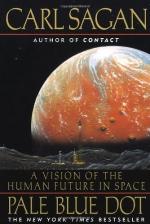
|
| Name: _________________________ | Period: ___________________ |
This test consists of 5 short answer questions, 10 short essay questions, and 1 (of 3) essay topics.
Short Answer Questions
1. Sagan says that the moon was once understood as a symbol of which of the following?
2. When did a "disrupted" comet famously fall into Jupiter?
3. Why does Sagan say that Mars is a more desirable target for human exploration than the moon?
4. What hazard from nuclear weapons causes "nuclear winter"?
5. What element does Sagan say motivated the space programs of the 60s and 70s?
Short Essay Questions
1. What is unusual about the surface of Venus?
2. How is Venus different from Earth?
3. Why does Sagan believe that America sent men to the moon?
4. What location in the solar system either have or are believed to have once had volcanoes?
5. How could planetary tides pull a small planet apart?
6. How does Sagan believe that humanity will progress in the next hundred or so generations?
7. How is Venus similar to Earth?
8. What major environmental catastrophes does Sagan warn against in Chapter 14, "Exploring Other Worlds and Protecting One"?
9. What does Sagan say that it is probably the fate of humanity to "live in the dark"?
10. How well can an asteroid's path be calculated?
Essay Topics
Write an essay for ONE of the following topics:
Essay Topic 1
Venus was once considered to be a "sister planet" to Earth, but is now known to be dramatically different from our own planet.
1) Discuss the characteristics of Venus, including the oddities in its climate, atmosphere, and surface.
2) Explain some of the similarities and differences between Earth and Venus and explain why this planet was once considered a "sister planet" to Earth.
3) Discuss Venus' unique place in the mythologies of ancient cultures around the world, as well as its unique positioning in the night sky as seen from Earth.
Essay Topic 2
Saturn is known for its beautiful ring system, although at the time this book was written, it was not known how or why planets formed rings.
1) Describe the planet Saturn, its ring system, and its moons.
2) Summarize some of the important information that the Voyager probes gleaned from their passage of the planet.
3) Discuss how planetary tidal forces are believed to contribute to the formation of ring systems.
Essay Topic 3
Much of Sagan's discussion in this book centers on the idea that human beings are wanderers by nature. He sees this aspect of the human character as obvious and critical.
1) Explain Sagan's conception of how and why early humans were wanderers.
2) Discuss the ways that Sagan believes human beings cope with the desire to wander in the setting of increasingly sedentary civilizations.
3) Discuss some of the endeavors in space exploration described in the book in terms of the human desire to wander and explore.
4) Explain Sagan's opinion about how humans will become nomadic wanderers again in the future.
|
This section contains 810 words (approx. 3 pages at 300 words per page) |

|




